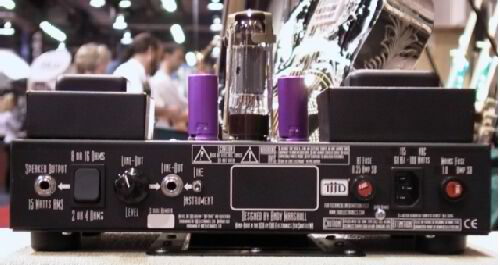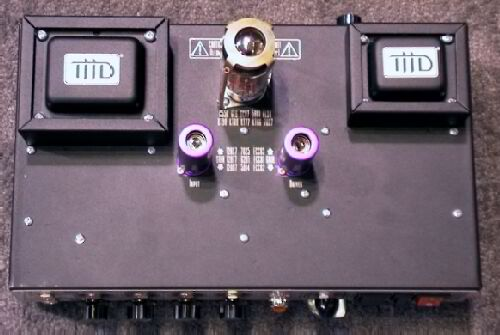Home (amp tone and effects placement)
THD - UniValve and BiValve

The above image is from http://www.thdelectronics.com.
Prototype:



The above 3 images are from http://www.harmony-central.com.
http://www.thdelectronics.com/products/univalve.htm - official product page
http://namm.harmony-central.com/WNAMM01/Content/THD/PR/UniValve.html - Jan. 18, 2001, THD announces UniValve amps are entering or re-entering production.
15 watt head with attenuator
THD - UniValve head. $949 list. 15 watt tube head with power attenuator and line-out. 6L6. Can accomodate EL34, 6550, 8417, 6EY6, 6EZ5, 5881.
Quiet cranked-amp product expert Ken Brakebill wrote:
THD makes the Univalve amp, using a single 6L6/5881/6550/EL34 for about 12-15 watts and several power level adjustment features. You choose the sound you want.
http://www.thdelectronics.com/pdf/univalve.pdf - PDF brochure for UniValve. (For best view, do Right-click, Save As. Then in Acrobat, do View: Full Screen.)
Below, you see evidence of the UniValve around July 1996. The amp has been developed and tested for 5 years. THD reports that tube life is about 3 years, and the amp is sturdy and reliable.
http://www.fredsguitar.com/amps.htm#thd - "And dare I say that the long awaited (six years!) Univalve Amp may be surfacing soon... This is a cool little 15 watt single ended output tube (octal) amp with a built in attenuator, line out, separate clean and overdrive jacks, and great sound... Very useful and even giggable... stay tuned..."
See also
thdhotplate.htm - THD Hot Plate power
attenuator with volume fine-adjust, Line Out jack with Level control, and
high-level Bass and Treble boost switches
thdyellowjackets.htm - THD Yellow Jackets
tube convertor sockets
Research links
THD Univalve
+THD +Univalve
Click these custom links to find the latest information and discussion about this product.
Article at Harmony Central (NAMM announce)
user reviews for this manufacturer at Harmony Central
product news for this manufacturer at Harmony Central (pending)
search newsgroup postings at Deja.com
Cascading a series of UniValve amps; using a UniValve with Line Out as a power-tube saturation pedal
It's great that people are interested in the UniValve. I phoned THD
about
six months ago to ask whether it was available or not. People showed
greater interest in the UniValve than any other product announced at NAMM.
(See ratings at bottom of
http://namm.harmony-central.com/WNAMM01/Content/THD/PR/UniValve.html
.)
This type of processing chain produces a great multiplied power-tube
saturation sound at any volume. I'm using low-wattage amps other than the
UniValve, with the THD Hot Plate and other power attenuators as dummy loads.
UniValve #1 at 7% power-tube saturation
UniValve #1's full dummy load and Line Out jack
UniValve #2 at 7% power-tube saturation
UniValve #2's power attenuator
Guitar speaker pushed to 3/4 watt
That is, instead of using overdrive pedal > tube power amp, use tube power
amp > tube power amp.
However, I've done more testing of such processing chains, and find that placed before power-tube saturation, you can interchange any of these distortion devices with different, valuable results: overdrive, distortion, power-tube saturation. Using an overdrive pedal before power-tube saturation sounds great and smooth. Using a power-tube saturation pedal before the main power-tube saturation also sounds great, but with a more wild, natural, attacky sound, more of a mechanical meltdown sound than the tightly controlled and domesticated "overdrive pedal" sound. I would expect a chain of distorted UniValves to sound different, this way, compared to the standard overdrive > power-tube saturation chain.
The UniValve would be excellent as a power-tube saturation pedal in front of any amp, with this chain:
overdrive pedal or distortion pedal
UniValve as power-tube saturation pedal, Line Out
Any guitar amp -- that is, any amplifier, run clean, driving a guitar speaker
I am looking forward to a literal power-tube saturation pedal with an actual
traditional power tube such as EL84, wired to always push a dummy load, in a
stompbox format. The UniValve comes very close to this new type of
distortion box, a power-tube saturation pedal. Then I would do this
chain:
EQ pedal
Power-tube saturation pedal
EQ pedal
Power-tube saturation pedal
EQ pedal
Linear amp
Guitar speaker pushed to 3/4 watt
I will demo this chain on the Amp Tone reference/test input library CD-R I'm
working on. It's the most interesting distortion approach I've heard.
Overdrive pedals claim to sound like a cranked tube amp. If a cranked
tube
amp is what we want, then we should simply insert a cranked tube amp with
dummy load, rather than an overdrive pedal. It works well for classic
sounds (at any volume), unless the buzzy preamp-distortion sound is
considered classic. For the buzzy "Saturday morning guitar
store"
preamp-dominant sound, remove the first power-tube saturation pedal and
insert a Tube Driver-type of preamp-tube distortion pedal. Fit into the
classic chain, this placement results:
Compressor pedal
Power-tube saturation pedal
Overdrive pedal
Distortion pedal
Tube power amp
Guitar speaker
Since the power-tube saturation pedal is being used as a
softer-than-overdrive preamp pedal, for placement, I work backwards from the
hard-edged distortion box, to the softer overdrive box, to the softest: the
power-tube saturation pedal. I will set up a BOSS Line Switcher pedal
(again) to create a stompbox from a tube power amp and dummy load, and try
swapping this pedal's positioning vs. the overdrive and distortion pedal.
In any case, assuming you will use *either* the overdrive pedal or
distortion pedal or power-tube saturation pedal, but not combinations, it
doesn't matter the relative order. The main point is that you are
stomping
on the 3 pedals to swap which type you are using. Sometimes for preamp
distortion you want hard-edged "distortion" clipping, sometimes you
want
soft "overdrive" clipping, and sometimes you want ultra-soft
"power-tube
saturation" clipping. In all cases, later in the chain is a tube
power amp
with a slight amount of saturation, pushing a guitar speaker (perhaps
through a power attenuator).
-- Michael Hoffman
Amptone.com
p.s. If you are looking forward to receiving the Amp Tone reference and
test-input library CD-R I'm going to send out, it would help a lot if you
would start gathering clips of album amp tone samples and direct/dry
electric guitar playing. http://www.amptone.com/reamp.htm
Amptone.com ultra gear-search page
Home (amp tone and effects placement)